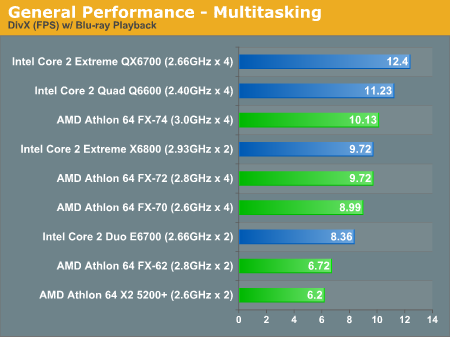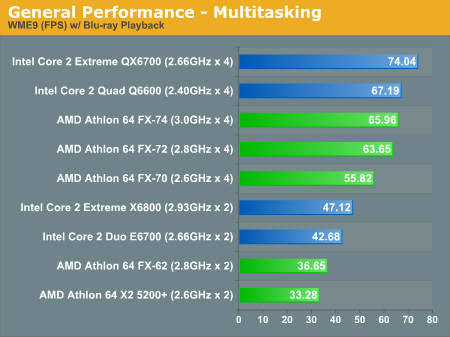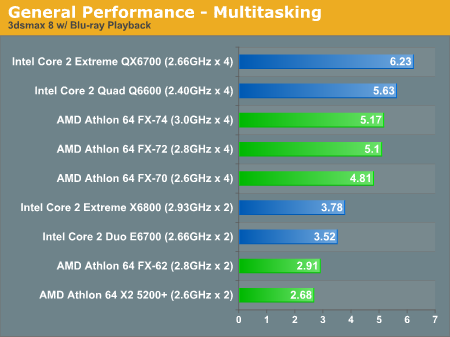AMD's Quad FX: Technically Quad Core
by Anand Lal Shimpi on November 30, 2006 1:16 PM EST- Posted in
- CPUs
Multitasking Performance
When we were trying to think up new multitasking benchmarks to truly stress Kentsfield and Quad FX platforms we kept running into these interesting but fairly out-there scenarios that did a great job of stressing our test beds, but a terrible job and making a case for how you could use quad-core today.
Without a doubt, in the next two years the number of applications that see a benefit when running on four cores will increase dramatically. Even multitasking under Windows Vista will make the argument for more cores easier (simply opening a new Explorer window in Vista will eat up 10% of the CPU time of a Quad FX system), but our Vista benchmarks are not yet complete and we wanted to have something to showcase for this review.
While working on our Quad FX article we also happened to be working on a follow-up to our HDCP Graphics Card Roundup, focusing on H.264 decoding performance in Blu-ray titles. A light bulb went off and we had our benchmark: how many cores do you need to watch a high bit-rate Blu-ray movie and do something else at the same time on your PC?
The movie we used was Xmen III, encoded in H.264, and featuring bitrates in excess of 40Mbps at times. Our benchmark starts at the beginning of Chapter 18 and continues until our background tasks are complete. This particular segment ranges in bitrate from 13Mbps up to above 40Mbps, with the average falling in the 18 - 24Mbps range.
We played the movie in the foreground, while in the background we either ran our Cinebench test, encoded a DivX movie, encoded a WME9 movie or performed our 3dsmax test.
The two rendering tests are important because rendering can take a bit of time and it might be nice to entertain yourself with a movie while your rendering completes; after all, what's the point of having $1000 worth of CPUs if you can't use them for entertainment?
The two encoding tests are also important because being able to encode and decode at the same time is a fundamental requirement for a DVR, and at some point the next-generation of media center PCs will need to be able to decode high bitrate HD movies while encoding others. We chose to include both DivX and WME because DivX runs much better on Intel CPUs, while the standings are a bit closer under WME, to give you a better overall impression of how the two platforms handle these heavy multitasking scenarios.
Our first test involved us playing back the BD title while running our multi-threaded Cinebench test; we reported the Cinebench score upon its completion:

The dual core processors all fall to the bottom of the list and basically perform like single-core CPUs while decoding the Blu-ray movie. The quad-core setups do much better and perform very well, but all of the CPUs in this test were able to run without dropping any frames in the BD movie.
Making things a bit more difficult, our next test had the same movie playing back but this time we ran our DivX encoding test in the background. We reported the DivX encoding frame rate upon completion:

Performance is pretty much what you'd expect, although Intel's superior DivX encoding performance results in the Core 2 Extreme X6800 doing almost as well as the FX-74. What you don't see however is how well these systems played back the Blu-ray movie; none of the dual core setups were able to play the BD movie smoothly, not even the Core 2 Extreme X6800. The movie was basically unwatchable due to all of the pausing and stuttering.
All of the four core systems played the BD movie fairly well; although they all dropped some frames, it wasn't enough to totally ruin the experience.
Next up we tried playing our BD title while running our WME9 test, and found similar results:

Once again, none of the dual core platforms were able to play the BD title even remotely smoothly. The quad-core setups were able to play the movie while encoding, but still managed to drop some frames (not enough to ruin the experience though).
Our final multitasking test has us playing the same BD title while running our 3dsmax 8 render test:

Much to our disappointment, none of the systems could handle this workload without ruining the movie playback; even the quad-core setups had troubles. We're not talking a few dropped frames, but rather the movie playback would be completely stopped at times. It looks like we may have a scenario for either more GPU assisted H.264 decode or an 8-core Quad FX platform in the future.










88 Comments
View All Comments
peternelson - Thursday, November 30, 2006 - link
I image www.Scan.co.uk in the UK will stock both boards and cpus at realistic street pricing.
And I am seriously thinking of getting one, to put lots of PCIe cards into, and for use WITH A NUMA AWARE OPERATING SYSTEM.
Who knows, Asus may even release a bios upgrade for it!
And also note that there is a similar Asus "Deluxe" board not just the WS workstation variant, so may be a little cheaper.
My other options are a dual socket Opteron board (with expensive memory) or a Core2Quad, using Nvidia 680i chipset which gives less I/O capacity.
Anonymous Freak - Friday, December 1, 2006 - link
Or, you could go for a dual socket Xeon system. It would cost near the same, and you'd have the option of two quad-core processors RIGHT NOW. (Rather than late next year.)Of course, then you run into more expensive (and more power-hungry) memory. But if you are actually looking at such a system, a Xeon might be a better fit.
mino - Friday, December 1, 2006 - link
The problem IS the memory and I/O, these are the strenghts of this solution.Prices of cheap 4C WS solutions:
HIGHEST PERFORMANCE 4C: -> systems have comparable performance (Vista/XPx64 in account)
-------------------------------------------------
***Quad FX:
1pc FX-74 $1000
1pc MB $350
4pcs 1G RAM $400
1pc Fortron PSU $100
0pcs 8-port SATA controller $0
----------------
Total: $1750
***Core 2 Quad:
1pc QX6700 $1000
1pc MB $250
4pcs 1G RAM $400
1pc Fortron PSU $60
1pc 8-port SATA controller $150
---------------
Total: $1860
BEST VALUE 4C: -> systems have comparable performance[except QX6700] (Vista/XPx64 in account)
-------------------------------------------------
***Quad FX:
1pc FX-70 $600
1pc MB $350
4pcs 1G RAM $400
1pc Fortron PSU $100
0pcs 8-port SATA controller $0
----------------
Total: $1350
***Core 2 Quad:
1pc QX6700 $1000
1pc MB $250
4pcs 1G RAM $400
1pc Fortron PSU $60
1pc 8-port SATA controller $150
---------------
Total: $1860
***Opteron 2000:
2pcs 2216 $1200
1pc MB $400
4pcs 1G RAM $600
1pc Fortron PSU $100
1pc 8-port SATA controller $150
---------------
Total: $2450
***Xeon 5100:
2pcs 5150 $1200
1pc MB $400
4pcs 1G RAM $700
1pc Fortron PSU $100
1pc 8-port SATA controller $150
---------------
Total: $2550
IDEAL WS/PC Solution: (best value proposition, upgrade possible when necessary)
----------------------------------------------
1/2pcs FX-70 $300
1pc MB $350
2pcs 1G RAM $200
1pc Fortron PSU $60
0pcs 8-port SATA controller $0
---------------
Total: $910
The funny thing beeing, the biggest value of QuadFX is in the exceptional motherboard. Except those those 10 not routed USB ports, that board is a dream come true.
And yes, those 12 SATA3G ports would be a blessing for my storage needs...
peternelson - Friday, December 1, 2006 - link
Nice costings, I'm thinking the same here.
That board has lots of I/O bandwidth.
Since the Gbit ether ports support teaming (2 muxed together), I would have thought it worthwhile for Asus to implement all four rather than two.
Four used separately would make nice routing between lans, and four used as two teamed pairs would give > 1Gbps performance in and out eg as a firewall, or as a server with redundant connection, or to talk to NAS boxes etc. Two extra nets wouldn't push the power consumption up by much.
Hopefully Asus (or other) will produce a rev2 board with the extra ethernets.
Lonyo - Thursday, November 30, 2006 - link
There's support for 14 USB ports AFAIK, 4 on the back, and 5 headers on the mobo, which makes 14 I think, which still isn't 20, but it's more than enough, and it's more than 10 :P
mino - Friday, December 1, 2006 - link
No, those 2 headers are for IEEE1394...SLIM - Thursday, November 30, 2006 - link
Is this just a prelim review only talking about the processors and the real review is still to come? I mean the only reason for this platform to exist is the 4 GPUs not the cpus. Let's see 4 8800gtx's with the FX74s playing at insane resolutions in games that intel simply can't fathom due to the lack of support for 4 gpus (at least as far as I know of).The 4 gpus are the point of this platform, not power consumption, not 3dsmax... GAMES WITH 4 GPUS! I don't mean to be too abrupt, but the boards got 4 graphics slots for a reason.
Spoelie - Friday, December 1, 2006 - link
A single 8800gtx is already being bottlenecked by a core 2, let alone them in SLI.Quad SLI will not have any performance advantage over SLI, as the processing power to feed them is just not there.
PrinceGaz - Thursday, November 30, 2006 - link
I dread to think what the power consumption of a system with the FX-74s and four 8800GTX cards would be. It would probably be close to 1KW, possibly even around 1100W or so. That would be insane!JarredWalton - Thursday, November 30, 2006 - link
Given that this "4x4" initiative is apparently going to use NVIDIA graphics cards, and NVIDIA makes both AMD and Intel chipsets, if they decide to do anything with quad G80 chips you can pretty much guarantee that it will be for both platforms. Thus, 4x4 is really 2x2 right now, whereas the 775 platform is 1x4 and Xeon is 2x4. In the future, AMD will have 2x4, and perhaps all the platforms will support some silly quad GPU configuration.Basically, quad SLI was all about the pissing contest. "Oh yeah, well I have for GPUs and you only have two!" Then there was the completely bogus marketing material that they sent out with quad SLI talking about how great the extra GPUs would be for accelerating physics calculations. I suppose it's possible that in the future such applications will become useful, but almost a year after the initial talk of NVIDIA physics acceleration and we have yet to see any actual demonstration of this capability. Anyway, this Quad FX is just the same thing as Quad SLI: potentially good marketing, but lackluster final performance and terrible heat and power requirements.